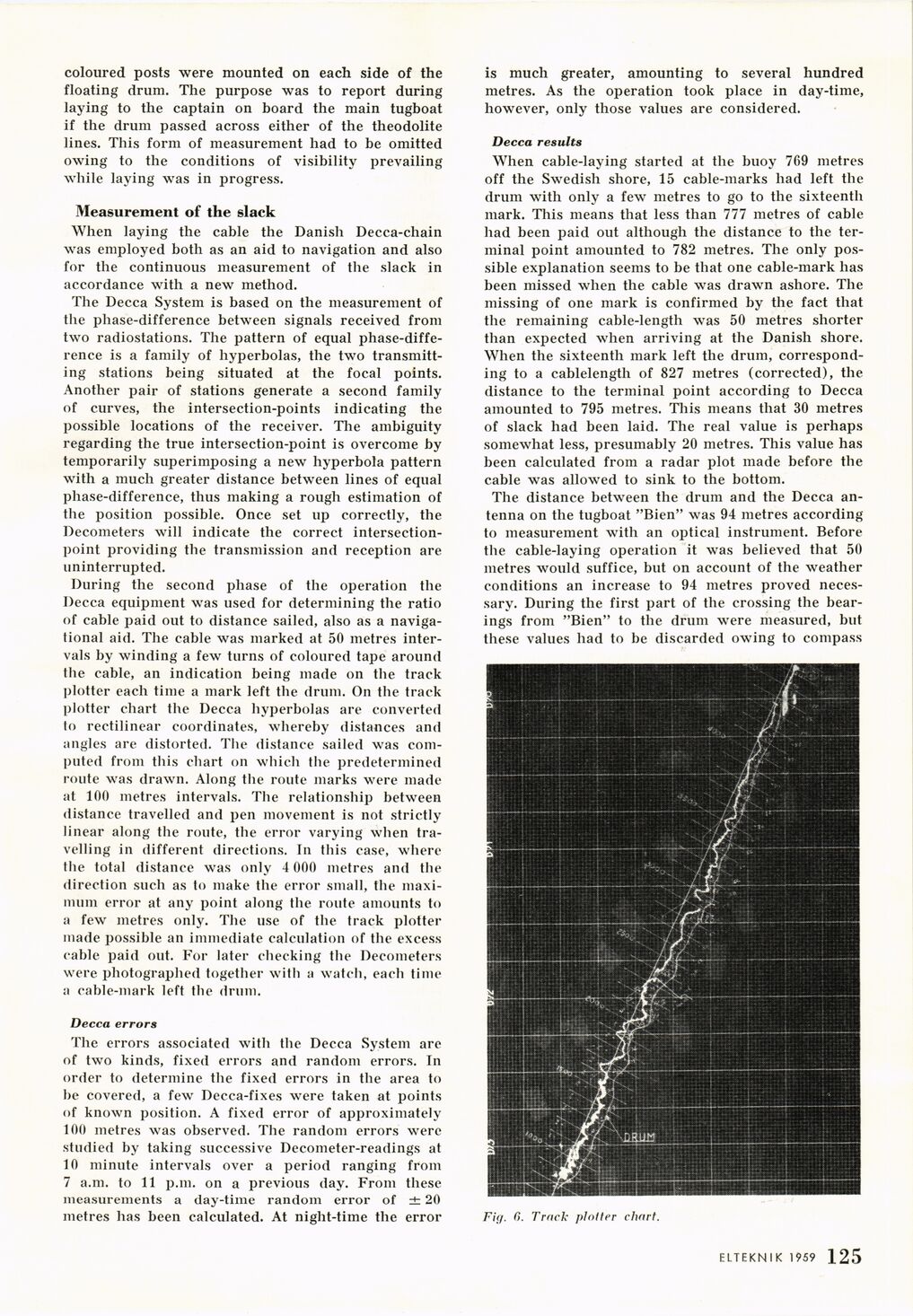
Full resolution (JPEG) - On this page / på denna sida - The Öresund Power Cable of 1958, by Anders Bergman, Wilhelm Carlshem and Gottschalk von Geijer

<< prev. page << föreg. sida << >> nästa sida >> next page >>
Below is the raw OCR text
from the above scanned image.
Do you see an error? Proofread the page now!
Här nedan syns maskintolkade texten från faksimilbilden ovan.
Ser du något fel? Korrekturläs sidan nu!
This page has never been proofread. / Denna sida har aldrig korrekturlästs.
coloured posts were mounted on each side of the
floating drum. The purpose was to report during
laying to the captain on board the main tugboat
if the drum passed across either of the theodolite
lines. This form of measurement had to be omitted
owing to the conditions of visibility prevailing
while laying was in progress.
Measurement of the slack
When laying the cable the Danish Decca-chain
was employed both as an aid to navigation and also
for the continuous measurement of the slack in
accordance with a new method.
The Decca System is based on the measurement of
the phase-difference between signals received from
two radiostations. The pattern of equal
phase-difference is a family of hyperbolas, the two
transmitting stations being situated at the focal points.
Another pair of stations generate a second family
of curves, the intersection-points indicating the
possible locations of the receiver. The ambiguity
regarding the true intersection-point is overcome by
temporarily superimposing a new hyperbola pattern
with a much greater distance between lines of equal
phase-difference, thus making a rough estimation of
the position possible. Once set up correctly, the
Decometers will indicate the correct
intersection-point providing the transmission and reception are
uninterrupted.
During the second phase of the operation the
Decca equipment was used for determining the ratio
of cable paid out to distance sailed, also as a
navigational aid. The cable was marked at 50 metres
intervals by winding a few turns of coloured tape around
the cable, an indication being made on the track
plotter each time a mark left the drum. On the track
plotter chart the Decca hyperbolas are converted
to rectilinear coordinates, whereby distances and
angles are distorted. The distance sailed was
computed from this chart on which the predetermined
route was drawn. Along the route marks were made
at 100 metres intervals. The relationship between
distance travelled and pen movement is not strictly
linear along the route, the error varying when
travelling in different directions. In this case, where
the total distance was only 4 000 metres and the
direction such as to make the error small, the
maximum error at any point along the route amounts to
a few metres only. The use of the track plotter
made possible an immediate calculation of the excess
cable paid out. For later checking the Decometers
were photographed together with a watch, each time
a cable-mark left the drum.
Decca errors
The errors associated with the Decca System are
of two kinds, fixed errors and random errors. In
order to determine the fixed errors in the area to
be covered, a few Decca-fixes were taken at points
of known position. A fixed error of approximately
100 metres was observed. The random errors were
studied by taking successive Decometer-readings at
10 minute intervals over a period ranging from
7 a.m. to 11 p.m. on a previous day. From these
measurements a day-time random error of ± 20
metres has been calculated. At night-time the error
is much greater, amounting to several hundred
metres. As the operation took place in day-time,
however, only those values are considered.
Decca results
When cable-laying started at the buoy 769 metres
off the Swedish shore, 15 cable-marks had left the
drum with only a few metres to go to the sixteenth
mark. This means that less than 777 metres of cable
had been paid out although the distance to the
terminal point amounted to 782 metres. The only
possible explanation seems to be that one cable-mark has
been missed when the cable was drawn ashore. The
missing of one mark is confirmed by the fact that
the remaining cable-length was 50 metres shorter
than expected when arriving at the Danish shore.
When the sixteenth mark left the drum,
corresponding to a cablelength of 827 metres (corrected), the
distance to the terminal point according to Decca
amounted to 795 metres. This means that 30 metres
of slack had been laid. The real value is perhaps
somewhat less, presumably 20 metres. This value has
been calculated from a radar plot made before the
cable was allowed to sink to the bottom.
The distance between the drum and the Decca
antenna on the tugboat "Bien" was 94 metres according
to measurement with an optical instrument. Before
the cable-laying operation it was believed that 50
metres would suffice, but on account of the weather
conditions an increase to 94 metres proved
necessary. During the first part of the crossing the
bearings from "Bien" to the drum were measured, but
these values had to be discarded owing to compass
Fig. G. Track plotter chart.
ELTEKNIK 1959 1 125
<< prev. page << föreg. sida << >> nästa sida >> next page >>